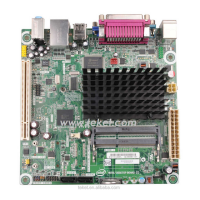
Do you have a question about the Intel D425KT and is the answer not in the manual?
| Form Factor | Mini-ITX |
|---|---|
| CPU | Intel Atom D425 |
| Memory Slots | 1 x DDR3 SO-DIMM |
| Max Memory Supported | 4 GB |
| Memory Speed | DDR3 800 MHz |
| Integrated Graphics | Intel GMA 3150 |
| USB Ports | 6 x USB 2.0 |
| Video Output | 1 x VGA |
| Chipset | Intel NM10 Express |
| SATA Ports | 2 |
| Audio | HD Audio |
Details specification changes and clarifications applied to the Intel Desktop Board D425KT/KTW.
Information on design defects or errors known as errata, documented in a separate Specification Update.
Identifies the target audience for the Technical Product Specification (TPS).
Outlines the chapters and their respective descriptions within the document.
Explains conventions used in the specification, including symbols and abbreviations.
Defines symbols used for notes, cautions, and warnings to highlight important information or risks.
General introduction to the Intel Desktop Board D425KT/KTW, including its purpose and scope.
Illustrates the physical arrangement of major components on the motherboard.
Presents a functional block diagram of the board's major areas and interconnections.
Lists web resources for obtaining product information, driver updates, and technical support.
Describes the Intel Atom processor, its cooling method, and integrated memory controller.
Details the features and capabilities of the integrated Intel Graphics Media Accelerator 3150.
Specifies memory features, socket types, supported configurations, and speed limitations.
Explains the role of the NM10 Express Chipset as the board's I/O controller.
Explains the real-time clock and CMOS memory powered by a coin-cell battery.
Details the features of the legacy I/O controller, including ports and associated functions.
Covers the LAN subsystem, including the Ethernet controller, connector, drivers, and LED status.
Describes the Intel High Definition Audio subsystem, its features, software, and connectors.
Explains hardware management features like thermal/voltage monitoring and chassis intrusion detection.
Details power management implementation, including ACPI, system states, and wake-up events.
Details the system's addressable memory space and its schematic representation.
Describes the board's connectors and headers, divided into back panel and component-side groups.
Explains the function of the BIOS configuration jumper block for setting BIOS modes.
Covers mechanical aspects of the board, including form factor, dimensions, and chassis compatibility.
Details electrical specifications related to fan headers and add-in board power.
Provides guidelines and requirements for thermal management, heatsink design, and chassis airflow.
Details power measurements for minimum and maximum load configurations, including test results.
Explains Mean Time Between Failures (MTBF) prediction and provides the board's MTBF.
Lists the environmental specifications for the board, including temperature, shock, and vibration.
Introduces the Intel BIOS, its storage, functions, and setup program access.
Details the organization and size of the BIOS Flash Memory (SPI Flash) device.
Explains how the BIOS automatically configures PCI devices and manages system resources.
Explains SMBIOS as a method for managing computers and the information it reports.
Enables USB devices before operating system drivers are available, for setup and installation.
Details utilities for updating the BIOS and precautions to prevent incompatible BIOS installation.
Lists acceptable drives/media types for BIOS recovery if an update is interrupted.
Allows augmenting the default Intel splash screen with a custom splash screen.
Allows users to choose boot devices like hard drive, optical drive, removable drive, or network.
Includes security features like supervisor and user passwords to restrict BIOS Setup and boot access.
Lists BIOS beep codes used to signal status messages and recoverable errors during POST.
Describes front-panel power LED blink patterns that indicate recoverable errors during POST.
Lists BIOS error messages displayed during POST and provides a brief explanation for each.
Explains POST codes generated during POST and their use in diagnosing errors.
Provides information on safety standards, EU declaration, ecology statements, EMC standards, and certification marks.
Lists safety standards that the board complies with when installed in a compatible host system.
Declares conformity with EU directives for CE marking, including EMC, Low Voltage, and RoHS.
Provides information on product ecology concerns, disposal, and recycling considerations.
States that the board complies with EMC regulations listed in Table 44.
Details FCC compliance for the device, including conditions for operation and interference.
Confirms the digital apparatus does not exceed Class B limits for radio noise emissions in Canada.
Provides the VCCI Class B statement for Japan, warning about potential radio interference.
States the Korea Class B statement, suitable for home use and residential areas.
Confirms compliance with e-Standby and ErP requirements, including EPEAT and EU directives.
Shows and describes the regulatory compliance marks found on the board.
